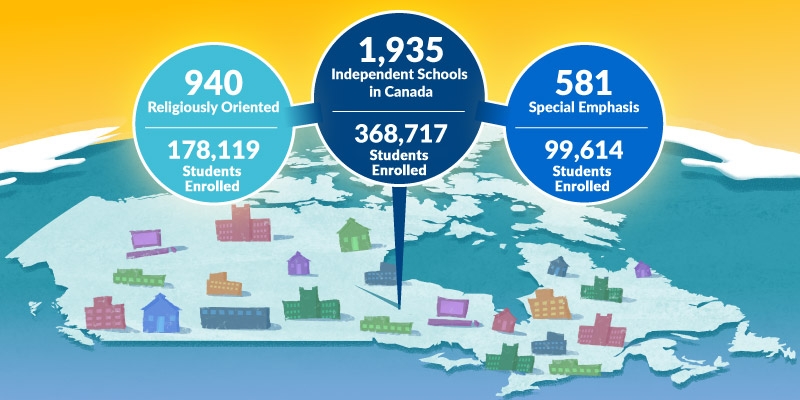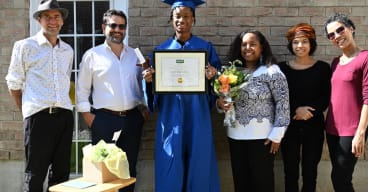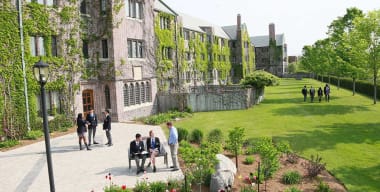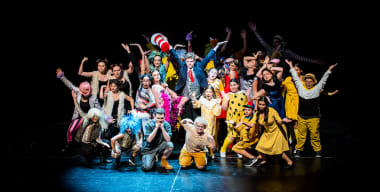Van Pelt is director of the Fraser Institute's Barbara Mitchell Centre for Improvement in Education. She is also co-author of A Diverse Landscape: Independent Schools in Canada, published by the institute in June of 2016. The study is the first of its kind in Canada, and provides what is by far the most comprehensive portrait of independent schooling in this country to date.
And there are some surprises. What first catches a reader’s attention is the number of students that attend independent school, totaling 6.8% of the national K to 12 student population. That number has grown consistently over the past decades, nearly tripling since the 1970s. “A greater number of parents,” writes Van Pelt, “[are] choosing to have their children educated outside of the public school system.”

Graphic courtesy the Fraser Institute. Used with permission.
There’s another surprise too: they aren't necessarily who we think they are. “Rigid typecasting of independent schools is more myth than reality,” the authors report. “In Canada, the lingering stereotypes are not reflective of the landscape,” namely that private schools are all the same and, together, serve a very narrow portion of the student population:
“... the parents of over 368,000 students—one of every fifteen students in Canada—are sending their children to one of the 1,935 independent, non-government schools in the country, and the picture is clear. They are choosing schools that differ in many ways from one another, the vast majority of which do not conform to the prevailing caricature that private schools in Canada are exclusive enclaves serving only the wealthy urban elite.”
Still, the stereotypes persist, something that Van Pelt and others believe isn’t merely unfortunate, but potentially detrimental. “The widespread misperceptions of independent schools,” she writes, “impede honest debate about why thousands of families make the additional financial sacrifice to send their children to these schools.” Especially in light of her recent findings, Van Pelt says it’s time for Canadians to “understand and recognize the tremendous value and choice provided by independent schools to the education system.”
Learning in the Canadian context
The public school system in Canada is vast. It is comprised of a network of provincial and regional boards that are free to adapt curriculum, allocate funding, and set degree requirements. Aside from a core curriculum, the public system offers additional programs based on need, interest, and what resources will allow: Catholic,[4] First Nations, Francophone curricula and French immersion. Some boards offer specialty programs, including gifted, remedial, athletics, and performing arts.
Nevertheless, those specialized programs are typically seen as simply addenda to the core public program, rather than essential parts of it. Likewise, when challenges are made to specialty schools and private schooling, they centre on the belief that a strong core program should take precedence, and that resources are best focused there rather than being diverted to serve a minority of students at the periphery.
“Everyone needs to be invested in our public schools in order for them to get better,”[5] writes Allison Benedikt in an op-ed piece for Slate magazine. She adds that some parents choose private school “for religious reasons, or because their kids have behavioral or learning issues, or simply because the public school in their district is not so hot. None of these are compelling reasons.”
It’s a typical criticism, regularly raised, in support of the common schooling model. The belief is that the public system is strong enough and adaptable enough to meet the needs of all students and all families.
Choice is important
Which all sounds good, of course, though the reality is that learning or behavioural issues, religious reasons, and quality are, in fact, compelling reasons. Among other things. “The idea of choice is attractive,” write Lynn Bosetti and Dianne Gereluk in their book Understanding School Choice in Canada, published this year by University of Toronto Press. “Its promise of equality, freedom, and democracy … reflects the modern desire for autonomy, control, and self-expression.”[6] And, when given a choice, parents historically take it, and they do so for compelling reasons: we’re changing, as a country, and therefore our needs are changing, too.
While common schooling has indeed worked very well for many, the reality is that choice has always been a considerable factor within it. It’s also nothing new. Roman Catholic schools have been a feature of public education in Alberta, Ontario, and Saskatchewan since each province entered confederation.
Ontario offers less financial incentive for alternative education than most of the other provinces, yet, even there, a large portion of students are enrolled in alternative programs. The most recent ministry data available was gathered in 2012/13. During that school year 26.5% of Ontario students were in enrolled in Roman Catholic English schools, 3.3% in Roman Catholic Francophone schools, 1.2% in Francophone schools, and 6% in independent or home schools. Taken together only 63.1% of students were enrolled in English public schools, [7] yet, even of those, 170 000 students were enrolled in public French immersion programs. Derek Allison writes that:
“Alternative schools within the boards also provide a less well-known form of school choice in Ontario including specialist arts and sports schools, single-gender schools, schools featuring more progressive or traditional approaches to the curriculum, and other themes and foci. Taken together, it might not be a stretch to claim that almost one-half of Ontario students attend schools of choice.”[8]
Parts of a whole
Rather than limiting that choice, many believe the quality of education were able to offer depends on increasing it. Dalton McGuinty Sr. (father of the past premier of Ontario) served on the Ottawa Board of Education for more than a decade and was a vocal initiator of provincial secondary school curriculum reform. He was also a very visible proponent of the combined benefits of both the common and private model:
“With students and teachers of diverse convictions, the public school must attempt a so-called neutrality on the great issues of life. It must operate with limited horizons. The independent-alternative school is able to assume a clearly defined philosophy of life and a specific orientation in accord with the values of its students and their parents. The public school must serve the interests of those who would keep that dimension out. The independent-alternative school can serve those who would keep it in.”[10]
It’s an understanding that remains with us, and which is at the heart of Bosetti and Gereluk’s book all these decades later:
“... the historical record suggests public schools have demonstrated little respect for diversity of thinking among different political, religious, and ethical stances. ... School choice has the potential to make provisions … for students whose identity and self-understanding depend on the vitality of their own cultural, religious, ethnic, racial, or gender context. In contrast, the common school model can present potentially constraining elements and limit their prospects.”[11]
It’s not about either/or, but the compatibility of both. All agree that the public education system, as McGuinty rightly suggested, provides a strong and necessary foundation for education in this country. It ensures that quality education is available and within the reach of all Canadians. It sets the tone for Canada’s educational system, public and private, and serves as a regulatory body for private and independent institutions. Most importantly, public schooling reflects the core educational values that Canadians share, namely to provide students an opportunity to realize their potential in becoming skilled, knowledgeable, caring citizens. The strength of Canadian private schools owes a lot to the strength of the public system.
Where we do ourselves a disservice, McGuinty suggested, is a failure to recognize that there are limits to what a public system can do, coupled with a lingering reluctance to acknowledge private schools’ value in augmenting and enlivening the national educational mosaic.
The system we have, the system we need
When he first developed the national system of education, Edgerton Ryerson intended it to mediate cultural differences and promote consistent social ideals within the nascent, post-colonial population. As chief superintendent for education in Upper Canada, he promoted free, secular, universal education. That ideal was then formalized in law with the Free School Act of 1864 and the Common Schools Act of 1871.
Ryerson believed that public education would provide a means of addressing a range of social problems—principally the high rates of crime and poverty—and ease the transition from an agricultural economy to one based in industrial capitalism. By adopting a secular curriculum, he hoped it would settle the social, class, and religious divisions that plagued the colonies. And he kept a tight leash. While the Lord’s Prayer was allowed when opening the school day, teachers were prohibited from teaching religion or displaying religious symbols, including clothing.[12] That was just as contentionus then as it would be today, if perhaps for different reasons.
Of the things that Ryerson didn’t intend, however, are many of the goals that we hold for education today: to promote creative thinking, to provide opportunities to pursue personal interests and skills, and to allow students to express their own thoughts and ideas. Ryerson wasn’t intending to provide a system to promote academic achievement, but rather to assimilate difference within the Canadian population. The residential schools, as misguided as they were, were born of similar impulses, and their effect rightly remains a source of profound national regret.
The population of the country isn’t what it was in Ryerson’s day, and the things we require of education aren’t the same, either. We desire an educational system that reflects the mosaic of Canadian cultural life, one that supports different learners, different traditions, and different goals. It’s a desire that is born of a sense of who we are and what we’d like for our children.
“Increasing levels of urbanization and immigration, and a shift to a knowledge-based economy requiring more highly skilled workers have intensified pressure on schools to reform the common schooling model. Pressure to reform this system of education has also come from marginalized and minority groups, who have contested the dominant ideologies implicit in and perpetuated by the common school movement. … these groups have sought accommodations for their culture, identity, values, and beliefs. In a similar vein, parents seeking more voice in the socialization and education of their children have looked for schools more in line with their family values, child-rearing practices, and aspirations for their children. These social, political, and economic factors have created the impetus for ministries of education and school boards throughout Canada to consider alternative schooling arrangements.”[13]
Parents, today, look to education to provide their child with an opportunity, in the words of Deryn Lavell, head of school at Bishop Strachan in Toronto, Ontario “to understand who she is, her place in the world, to become an independent young woman, to have a chance to learn leadership skills, [and] to find a voice in a multiplicity of voices.” Increasingly, they’re turning to private and independent schools in order to find it.
Notes
[1] Rob Reich “How and Why to Support Common Schooling and Educational Choice at the Same Time” Journal of Philosophy of Education. 41 (4):709-725 (2007).
[4] Roman Catholic separate schools have been a feature of the educational landscapes in Alberta, Ontario, and Saskatchewan since they became part of the Canadian confederation. Other provinces, such as Manitoba and British Columbia, have historically resisted the establishment of Catholic schools within their public education systems.
[6] Bosetti and Gereluk. Understanding School Choice in Canada. Toronto, University of Toronto Press, 2016. p. 3
[8] https://www.fraserinstitute.org/article/parents-should-have-greater-school-choice-in-ontario
[10] McGuinty, D. J. ((December 27, 1984). The relevance of independent alternative schools in society today. (Series RG 18-195, Box 4, File #395, Barcode B268930). Records of the Commission on Private Schools in Ontario, Archives of Ontario, Toronto, ON. p. 7
[11] Bosetti and Gereluk. Understanding School Choice in Canada. Toronto, University of Toronto Press, 2016. P. 24
[13] Bosetti and Gereluk. Understanding School Choice in Canada. Toronto, University of Toronto Press, 2016. p. 4










